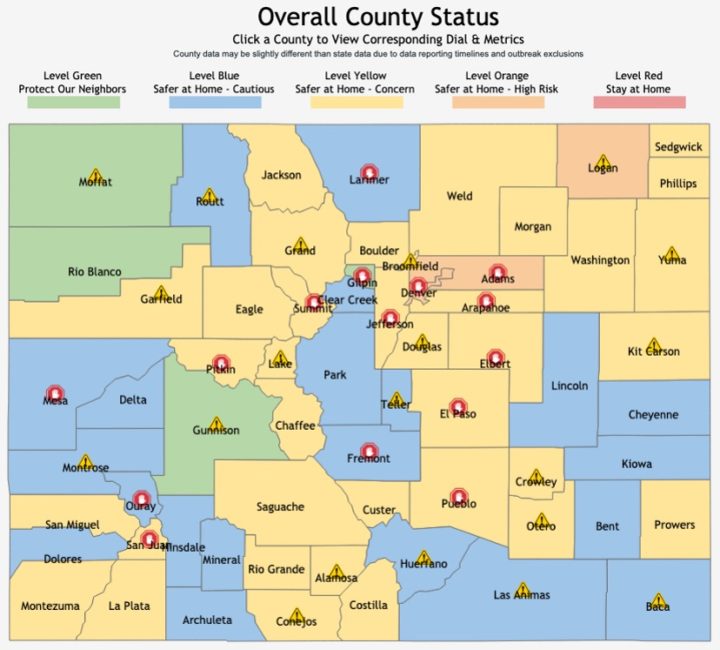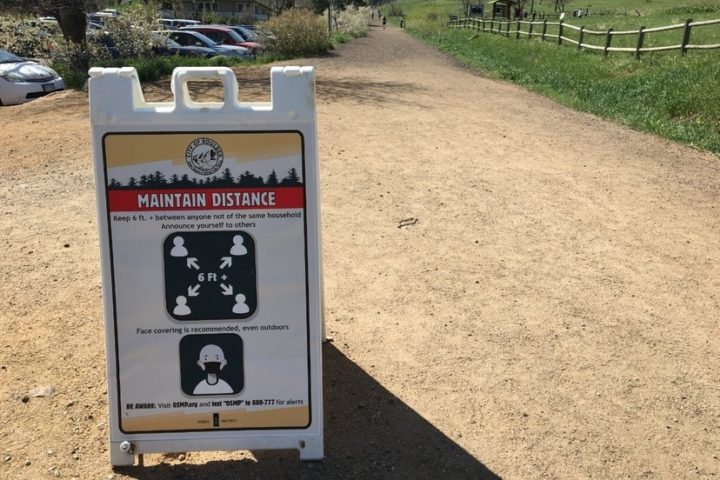“All the stars are aligned in the wrong place as you go into the fall and winter season, with people congregating at home indoors. You could not possibly be positioned more poorly…”
— Infectious-disease expert Anthony Fauci, as quoted in an October 31 article in the Washington Post.
Dr. Fauci may have been right… that we’re positioned poorly here in the US, for a Merry Christmas…
Taking Colorado as a whole, the picture is fairly bleak. The state’s previous high point for ‘new cases reported in a single day’ dates back to April 27, when 938 new cases were reported. The Colorado Department of Public Health and Environment (CDPHE) reported 3,255 new cases on Thursday, November 5… and 3,192 on Friday, November 6.
Here in Archuleta County, San Juan Basin Public Health (SJBPH) reported 8 new COVID cases last week. By comparison, Archuleta County had reported a total of 8 confirmed cases between March 26 and June 25 — a three-month period — and seven of them had recovered by June 25. But Archuleta County’s total number of cases since March — 77 residents and 64 non-residents — still puts us among the 20 ‘safest’ counties in Colorado. A few dozen miles to the west, La Plata County saw 109 new cases during the seven days between October 31 and November 6, a 25% increase in the reported case total, in the span of one week.
Looking at the larger picture, the United States had a tough weekend, after setting a new record with 104,004 new infections reported on Wednesday, November 4. Then, on Friday, November 6, John Hopkins University School of Public Health announced 132,797 new cases in the US. Over the past week, we’ve seen an average of over 100,000 new cases per day… an increase of 57 percent from the average two weeks earlier. This numbers pushed the total number of recorded cases in the US over 10 million, with the latest million added in just 10 days.
From the CDC website on November 5:
This week’s national ensemble forecast predicts that the number of newly reported COVID-19 deaths [in the US] will likely increase over the next four weeks, with 4,600 to 11,000 new deaths likely to be reported in the week ending November 28, 2020. The national ensemble predicts that a total of 250,000 to 266,000 COVID-19 deaths will be reported by this date.
Looking forward to winter, and more indoor activities, the CDPHE decided to re-name the capacity restriction levels on their COVID website. When the lock-downs first started in Colorado back in March, the entire state was treated to the same restrictions. As it became apparent that the virus was going to act differently in different counties, the rules became more flexible, allowing some counties to re-open more rapidly than others. Those ‘flexible’ rules are now causing some counties to lock down more severely than others, as coronavirus cases spike… heading into the holiday season…
Previously, the levels had been labeled “Stay at Home” — the most severe lock-down level — “Safer at Home, Level 3” — the next most serious level — “Safer at Home, Level 2”, and “Safer at Home, Level 1” … and with the most relaxed rules applying to the level called “Protect Our Neighbors”.
To make things simpler, for those of us who prefer our lock-down names based upon ‘colors’, CDPHE has thoughtfully re-named the containment levels, as shown below.
“Level Green” et cetera.
As of November 5, four counties had been granted “Level Green” status. Four counties were in Level Orange. No counties were in “Level Red” — the most severe level — on November 5.
By November 8, the map had changed somewhat. There were now three additional counties in Level Orange, and two counties that had been “Blue” increased to Level Yellow.
It seems possible, at this point, that a few counties might move into “Level Red” within the next week or two. That will mean harsh economic shutdowns for those counties, similar to what the entire state endured back in April.
New infections are particularly rampant in the general Denver area, including Adams, Broomfield and Boulder counties. From a press release from Denver Department of Public Health & Environment (DDPHE), dated November 6:
City officials announced new restrictions today to combat the dramatic increase of new COVID-19 cases and hospitalizations, including an order prohibiting public and private gatherings of any number of people not from the same household between the hours of 10pm and 5am.
Mayor Michael B. Hancock and DDPHE Executive Director Robert McDonald said the city will enact a ‘Home by 10’ order, effective for 30 days starting this Sunday, November 8, through Monday, December 7. People should be home by 10pm, with certain exceptions, including going to and from work, interstate travel, and getting medical care. Thanksgiving Day will be exempt.
This is not intended to be a traditional curfew, but rather a restriction on gatherings, business hours, and a guidepost for behavior that will help Denver get through the next 30 days. Any business not defined as critical must close to the public during Home by 10 hours. Critical businesses include, but are not limited to, hospitals, grocery stores, and pharmacies. No alcohol sales or consumption after 10pm will be permitted at any facility that sells alcohol, including restaurants and grocery and liquor stores. Restaurants will still be able to offer food takeout and delivery after 10pm.
Under the new order, groups at restaurants will now be limited to six people from no more than two households, down from 10 people, for the duration of the ‘Home by 10’ public health order.
One can easily form the impression, from this press release, that public health officials view evening alcohol consumption as one of the key drivers of coronavirus spread.
Health officials have increased restrictions in Boulder County after a sudden increase in new COVID-19 cases. Beginning Friday, the county moved to ‘Safer at Home Level Orange: High Risk’. Public health officials are urging residents to avoid all gatherings. The University of Colorado at Boulder (CU) is reportedly moving instruction to 100% online, starting next week.
State health officials are calculating new COVID infections among Boulder County residents at about 312 per 100,000 over the past two weeks. If the ratio gets to 350 per 100,000, the county will qualify for ‘Stay at Home’ — Level Red.
“It’s disappointing,” said City of Boulder Mayor Sam Weaver. “Everything about going into a lock-down would be bad.”
With the start of CU’s football season this past weekend, there’s more concern about a possible increase in cases.
“Be as careful and respectful as possible,” the Mayor advised, “going to football games, and tailgating, and watching at home, as much as you would be with anything else you’re doing.”
Good luck with that one.





